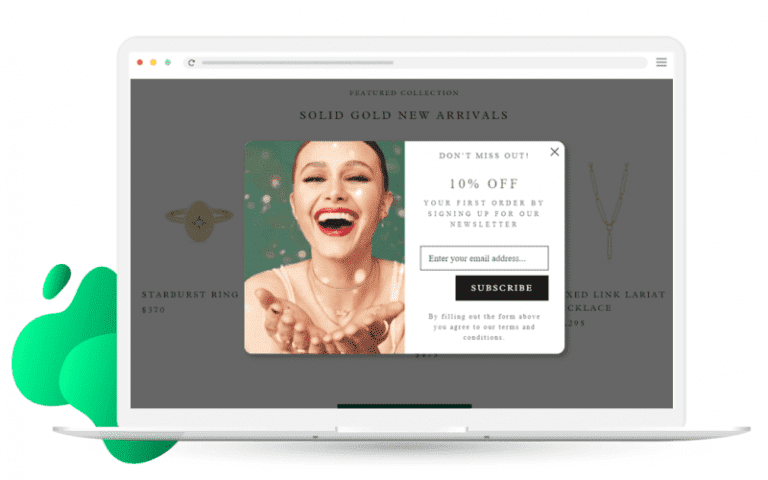Website Personalization Strategies and Best Practices

Web personalization enables you to create customized and human-like experiences at every stage of the customer journey. With 71% of customers expecting personalization, a one-size-fits-all approach just won’t work.
Let’s delve into website personalization, which is essential for creating engaging experiences that connect with visitors on a personal level. When mastered, web personalization becomes a marketer’s best friend, solving high bounce rates, converting new visitors, recovering abandoned carts and fostering long-lasting brand loyalty. We’ll explore where to start, what to personalize, and the challenges you might face.
What is website personalization?
Website personalization involves customizing your website content, offers, recommendations, and interactions based on individual user data, preferences, and behaviors. This includes browsing and purchase history, demographics, location, and device type. This approach can significantly improve your visitor’s experience by making their interactions relevant and engaging.
What are the benefits of website personalization
Website personalization is a strategy that you can use to customize your visitor’s experiences. Here are some benefits of incorporating website personalization:
Increases conversion rate
Personalization helps you convert visitors into paying customers. By showing relevant content and offers, you’re more likely to capture their attention and guide them towards the desired action, such as making a purchase or signing up for a newsletter.
Fosters brand loyalty
When customers feel valued and understood, they’re more likely to become loyal brand advocates. Personalization demonstrates that you care about their individual needs, fostering a stronger connection and encouraging repeat business.
Increases average order value
Personalized recommendations can nudge customers towards products they’re more likely to be interested in, potentially leading to them adding higher-value items to their carts.
Improves retention
A personalized experience keeps visitors engaged and coming back for more. By understanding their preferences, you can deliver content and offers they’ll find valuable, increasing the likelihood of them returning to your site.
Recovers abandoned carts
Personalized messages and retargeting campaigns can remind visitors about items left behind in their carts, prompting them to complete the purchase.
Saves time and money
Personalization helps you target your marketing efforts more effectively, leading to a better return on investment (ROI). You’ll spend less time and money on generic campaigns that may not resonate with your audience. Low-code or no-code personalization solutions allow marketers to modify the customer experience for thousands of visitors using simple drag-and-drop tools. This means less time waiting on dev for bespoke website elements, and more time testing and optimizing variants of personalized content.
Eight types of website personalization
From social proof and dynamic product recommendations to personalized content and urgency messaging, the possibilities for website personalization are endless. Let’s take a closer look at eight widely-used personalization techniques that you can utilize today.
1. Social proof
You can leverage the power of customer reviews, testimonials, and user-generated content to build trust and influence purchasing decisions. Showcase positive experiences from similar customers to build confidence and encourage conversions.
3. Dynamic product recommendations
Go beyond generic product listings. Use customer data and browsing behavior to suggest relevant products that each visitor is more likely to be interested in. This increases the chance of them discovering something they’ll love.
3. Personalized content
Tailor website content, including headlines, product descriptions, and blog posts, to resonate with different audience segments. This creates a more engaging experience and ensures visitors see information most relevant to their needs.
4. Urgency messaging
Create a sense of urgency with strategically placed messages that highlight limited-time offers, low stock availability, or upcoming sales. This can nudge visitors to take action before the opportunity disappears.
5. Dynamic navigation bars and banners
Personalize the navigation bar and banner content based on user data or location. This allows visitors to easily find what they’re looking for and promotes relevant products or offers. You can tailor these elements to the shopper’s browsing history or preferences.
6. Search personalization
Refine search results based on a user’s search terms, browsing history, and past purchases. This ensures visitors find the most relevant products quickly and efficiently, improving their search experience.
7. Live weather forecasts(location-based)
You can display relevant weather information that can influence your customer’s product choices. For example, showcasing raincoats during a downpour or suggesting sunscreen on a sunny day.
8. Popovers and notifications
Use personalized popovers and notifications to keep visitors informed and engaged. This could involve showcasing abandoned cart reminders, loyalty program updates, targeted coupons or personalized product recommendations.
By incorporating these website personalization techniques, you can create a more dynamic and engaging experience for your visitors, ultimately leading to increased conversions, customer satisfaction, and business growth.
Providing shoppers with highly relevant recommendations on the website is a crucial part of eCommerce personalization, as it is effective when it comes to generating sales and helps create a unified cross-channel shopping experience. By using customer data including their previous interactions on your website, your personalization efforts will be rewarded.
34 Must-Know Website Personalization Stats
Website personalization is a proven strategy that delivers impressive ROI and turns anonymous visitors into loyal customers. There’s no shortage of research-backed evidence showing its effectiveness. Marketers everywhere trust personalization to boost engagement and drive results. Ready to see the stats that prove its worth? Let’s dive in.
Benefits of website personalization
1. 89% of digital businesses are investing in personalization. (Forrester)
2. 4 in 5 companies (80%) report an uplift since implementing personalization. (Econsultancy)
3. 80% of consumers are more likely to do business with a company that offers personalized experiences. (Epsilon Marketing)
4. 71% of consumers expect personalization. (McKinsey)
5. 76% of consumers get frustrated when companies don’t use personalization. (McKinsey)
6. 80% of customers now consider the experience a company provides to be as important as its products and services. (Salesforce)
7. Personalization can increase the efficiency of marketing spend by 10 to 30 percent. (McKinsey)
8. 94% of companies experienced a rise in conversion rates after personalizing their websites. (Econsultancy)
9. Basic website personalization can give a 14% sales uplift. (Fresh Relevance)
10. 22% of consumers find it frustrating when they opt out of marketing emails about a specific event, such as Mother’s Day, but the online retailer then shows them promotions around the event when they visit the website. (Fresh Relevance)
11. 89%: of millennials are interested in receiving personalized offers, leading all demographics. (Pymnts)
Effective product recommendations
12. 45% of online shoppers are more likely to shop on a site that offers personalized recommendations. (Invesp)
13. 71% of eCommerce websites offer product recommendations. (Internet Retailing)
14. Personalized product recommendations can increase click-throughs by more than 100%, versus generic product recommendations. (Fresh Relevance)
15. 79% of consumers are willing to share relevant information about themselves for personalized product recommendations. (Salesforce)
16. 38% of consumers say they won’t return to an online retailer that recommends things that don’t make sense for them. (Salesforce)
17. Onsite product recommendations can give a 112% sales uplift. (Fresh Relevance)
18. Personalized product recommendations increase average order value by 10%. (Salesforce)
19. Personalized product recommendations can increase website conversion rate by 49%. (Fresh Relevance)
Engaging popups for personalization
20. More than half of online shoppers (57%) are OK with providing personal information as long as it is for their benefit. (Invesp)
21. The average conversion rate for all pop-ups is 3.09%. The top performers average 9.28% conversion rates. (Sumo)
22. A targeted popover can increase monthly subscribe rate by 600%. (Fresh Relevance)
Coupons for personalized shopping experiences
23. Coupon users spend 26% more than shoppers who don’t use them. (Blippr)
24. 68% of consumers are more likely to join a retailer’s/brand’s marketing list if they receive an instant coupon. (CodeBroker)
25. 68% of consumers say that coupons generate loyalty. (Invesp)
26. 67% of consumers are highly in favor of personalized coupons. (Infosys)
27. 74% of online shoppers prefer discounts that indicate “percentage off” savings. (Blippr)
28. 59% of shoppers look for discount codes before making a purchase online. (Invesp)
29. 1 in 4 consumers (25%) find it frustrating when a retailer sends them a coupon code but doesn’t show them the code anywhere on their website. (Fresh Relevance)
Leveraging location data for personalization
30. 67% of smartphone users say they’re more likely to buy from companies whose mobile sites or apps customize information to their location. (Google)
31. 80% of consumers say that they would like to get location-based alerts from businesses. (Linchpin)
32. 42% of consumers want online retailers to display stock availability in their nearest store for products they are browsing. (Fresh Relevance)
Personalized site search: enhancing user experience
33. 1 in 3 consumers (33%) get frustrated when the search results are irrelevant. (Fresh Relevance)
34. 1 in 4 consumers (24%) get frustrated when the results show out of stock items. (Fresh Relevance)
35. 1 in 5 consumers (20%) want to see alternative products when the search brings back no results. (Fresh Relevance)
How to create a website personalization strategy
Now that you understand the basics of personalization, let’s explore the steps to create your successful website personalization strategy:
Define your goals
The first step is to identify your specific goals for personalization. Do you want to increase conversions, boost average order value, or improve customer retention? Clearly defined goals will guide your entire personalization strategy.
Choose the right personalization tool
Choosing a user-friendly personalization tool is essential for effectively implementing your website personalization strategy. Fresh Relevance by Dotdigital can assist you with AI-powered product recommendations and real-time personalization across multiple channels.
Some benefits of using Fresh Relevance for your personalization strategy include:
- Easy integration with your existing marketing and ecommerce platforms
- AI-driven product recommendations tailored to individual shopper interests
- Real-time personalization to ensure your website remains relevant and engaging
- Seamless cross-channel personalization that’s compatible with email, SMS, and social media marketing.
By selecting Fresh Relevance as your personalization tool, you can streamline your personalization efforts, making better use of customer data to create a personalized shopping experience for each unique visitor.
Develop a personalization plan
Craft a plan that outlines how you will personalize different elements of your website. This could involve creating targeted content, displaying personalized product recommendations, or dynamically adjusting calls to action.
Gather and analyze data
Effective website personalization relies on one crucial element: data. To manage your data effectively, you can use a customer experience and data platform (CXDP). A CXDP is a comprehensive platform that enables you to effectively manage your customer experience and data.
Dotdigital CXDP acts as a central hub, collecting and unifying customer data from all your touchpoints. This creates a single, holistic view of each customer, allowing you to:
- Gain actionable insights: Analyze all your customer data in one place to understand their behavior, preferences, and lifecycle stage. This empowers you to personalize experiences more effectively.
- Simplify data management: Reduce data duplication and streamline data governance with a centralized platform. This saves time and resources, allowing you to focus on strategic personalization initiatives.
- Fuel cross-channel personalization: Utilize the unified customer profile to deliver consistent and personalized experiences across all channels, like email, mobile app push notifications, and website content.
Incorporating a CXDP like Dotdigital into your website personalization strategy ensures a better understanding and utilization of customer data, leading to more engaging and rewarding experiences for your site visitors.
Segment audience
Segmentation allows you to group shoppers based on similar characteristics for targeted marketing. Analyze customer data to build segments like:
- Lapsed vs. engaged shoppers
- High spenders vs. bargain hunters
- Specific demographics (young parents, DIYers, etc.)
- Product, brand, and price preferences
Develop targeted communications for each segment to increase engagement and conversions.
Know your audience
In-depth audience understanding is key. Segment your visitors based on demographics, interests, behavior, and purchase history. The more you know about your audience, the more effectively you can personalize their experience.
Collect additional data, if necessary
Once you’ve set up your CDP and analyzed and segmented your audience, you may find great reasons to collect more data:
- Add subscribers to your BAU newsletter
- Improve cart and browse recovery message conversions
- Increase sales with price drop, replenishment, and other behavior-triggered messages
- Improve the customer experience (CX) with personalized messages and on-site interactions
- Increase AOV through improved product recommendations
On-site data capture popovers
An effective data capture tactic is the on-site popover. They can be triggered by specific customer behavior, such as intent to exit. Popovers are great for engaging new visitors or re-engaging returning visitors who didn’t complete a purchase.
Since the popover appears at a relevant moment while shopping, visitors are likely to complete the form. You can also incentivize participation with a discount, coupon, or exclusive offer.
On-site data capture banners
Another popular data capture technique is the onsite banner that, once clicked, reveals a form or survey. The banner collects valuable customer data without interrupting your shopper’s browsing experience as much as a full-page popover.
Test and optimize
Personalization is an ongoing process. Continuously test and refine your efforts through A/B testing to discover what resonates most with your audience. Here’s the process:
A/B testing
- Create variations of your personalized elements, such as product recommendations, calls to action, or website layouts.
- Split your website traffic and show different variations to a portion of your visitors.
- Analyze the results to see which variation performs better based on your goals (conversions, engagement, etc.).
Refine your strategy
- Implement the winning variations from your A/B tests and update your personalization strategy accordingly.
- Continuously develop new hypotheses and test additional personalization tactics to keep optimizing the user experience.
By following this test-and-refine approach, you can ensure your website personalization efforts are constantly evolving and delivering the best possible results for your marketing.
What is dynamic content and why is it used for website personalization?
Unlike static content which remains the same for everyone, dynamic content engines use algorithms to automatically deliver content or content types most likely to resonate with the shopper. This personalization is based on the user’s actions, preferences, and contextual data.
Dynamic content allows you to personalize each section of your website or email in real-time, leading to:
- Higher customer engagement
- Improved conversion rates
- Reduced abandonment rates
- Enhanced customer loyalty
Website personalization best practice examples
Let’s delve into real-world examples of website personalization in action:
1. Dynamic product recommendations

The sporting goods retailer, GolfClubs4Cash implements a product recommendations carousel on product pages.
The carousel displays recommendations tailored to each visitor, such as “People like you bought” or “People who browsed this also looked at,” along with filters based on past purchases or browsing behavior.
This targeted approach increases the likelihood of visitors discovering relevant products they’re interested in, leading to a potential sales increase of 15%.
2. Cross-channel personalization

The beauty brand, Look Fabulous Forever leverages behavioral targeting to ensure a consistent shopping experience across all channels (website, email, social media).
Offers a visitor sees on social media or email are also reflected on the brand’s website. Additionally, the brand personalizes offers based on customer segments, encouraging them to try new product lines through targeted emails and website displays.
This cohesive approach reinforces brand messaging and caters to individual customer preferences, potentially leading to increased engagement and sales.
3. Strategic data capture

The jewelry store, Van Der Hout Jewelry revamps its data capture form to improve user experience and data collection.
The brand implemented a more user-friendly form that encourages visitors to sign up for the newsletter. Additionally, they control when the form appears to prevent interrupting the browsing experience.
This resulted in a 12% increase in newsletter signups and allowed for more targeted email marketing campaigns with personalized discount codes, potentially boosting sales conversions.
These examples showcase the diverse ways brands can leverage website personalization to create a more engaging and effective customer experience. By implementing similar strategies, you can personalize your website to cater to individual visitor needs and preferences, ultimately leading to improved customer satisfaction and business.
Website personalization is key to a successful cross-channel marketing strategy
Customers today expect a seamless and personalized experience at every touchpoint. Website personalization plays an important role in achieving this. By customizing your website content, offers, and recommendations for each visitor, you can create a more engaging journey that builds brand loyalty and drives sales.
Book a demo today and discover just how easy getting started with advanced website personalization strategies can be, with Fresh Relevance by Dotdigital.



